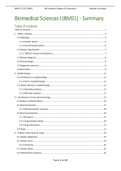Samenvatting
Summary McTimoney College of Chiropractic - Biomedical Sciences I
- Vak
- Instelling
This is a full summary of all lecture notes and slide decks from Biomedical Sciences I. This summary can be purchased together with potential exam questions provided by the lecturer with my own answers for each question for the same price! The bundle will also include an overview of the important i...
[Meer zien]




